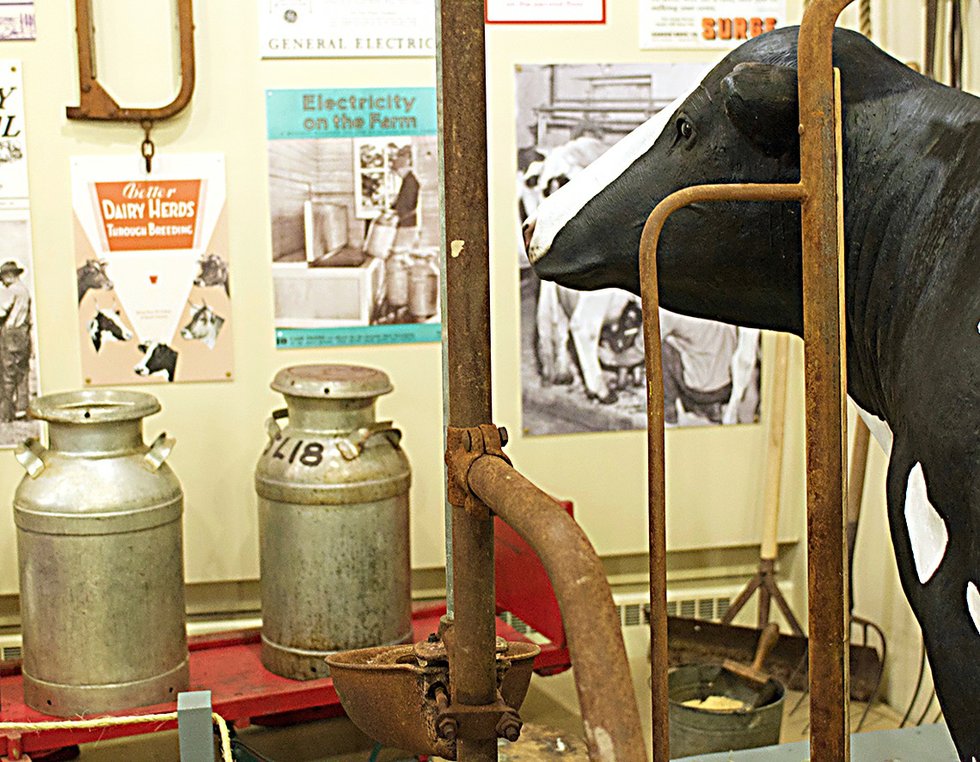(First published in the December 19, 2018 issue of City Pages)
Recent farm data puts a sobering spin on the Historical Society’s exhibit Milking Time

The Marathon County Historical Society’s exhibit Milking Time: Evolution of the Dairy Industry in Marathon County has been popular since it opened in June. It’s a fascinating look at how dairy farming began in the 1800s and progressed into the dynamic industry Wisconsin is known for around the world.
And it’s an auspicious year for this exhibit. Since it opened in June, about 20 dairy farms have gone out of business in Marathon County alone.
According to the United States Department of Agriculture National Agriculture Statistic Services, as of this month there are 495 dairy herds in Marathon County, compared to 536 in December 2017.
That’s more than 40 local dairy farms that have closed in just one year.
It’s a sad and sobering number to consider when viewing the exhibit. Milking Timeshows how, beginning in the 1800s, farms often only had a few cows to provide milk for family use with perhaps some leftover to make into butter or to trade. These early settlers gradually transformed their land into larger farming operations that produced milk for commercial sale. The industry then expanded, adding creameries and cheese factories that produced a range of dairy products, like ice cream and cheese curds.

The exhibit spans the entire history of how the county and farming practices adapted for the dairy industry. Larger barns were constructed to hold more cows and silos were needed to store large quantities of feed. Science and educational programs developed and farmers learned how to produce a higher quality and quantity of milk, which increased their profits.
With newspaper clippings, photos, pamphlets, atlases, barn models, a large fiberglass cow, oral history quotes and much more, the history of dairy farming in Wisconsin comes to life. It’s an eye-opening, “udderly” informative display with tons of fascinating facts.
Nonetheless, seeing the rich history of the dairy industry in the area, it’s disconcerting to also know the state of the industry today as the number of dairy herds in the area are rapidly decreasing.
Marathon County isn’t the only area seeing a decrease in dairy herds, it’s happening around the state, and has been for a number of years. There were 8,163 herds in Wisconsin as of December 2018 compared to 8,839 in December 2017—a loss of 676 farms statewide.
Low milk prices and an over-abundance of milk on the market have contributed to this downward spiral.
“It’s an industry of ups and downs” says local dairy farmer Jim Briggs, “but it’s been down for over three years.”
He started Briggs Family Farm in Stratford four years ago, but he’s been in the farming business his entire life as his parents owned a farm on the east coast. With over three years of low milk prices, dairy farmers are no longer earning enough money to maintain their business, he says.
The number of farms shutting down is concerning, Briggs tells City Pages, because you can do everything correctly, pass inspections and have good quality milk, but still be in danger of closing. While Briggs doesn’t personally know anyone who has needed to shut down their farm, he hears about it frequently.
In some cases, Briggs says, dairy farmers receive a letter from the company that purchases their milk to say they are no longer buying their product.
When dairy herds are eliminated, small, locally owned dairy farms often sell their cattle at an auction, according to Heather Schlesser, the Dairy Agent for the Marathon Co. UW-Extension. These animals may be purchased to be slaughtered or larger dairy farms that are looking to expand may buy them for milking. Larger farms continue to grow as the dairy industry has been shifting toward big, corporate farms.
In other words, the number of milking cows isn’t dropping, just the number of farms. And it’s happening everywhere say Briggs. “Small farms are being forced out, yet cow numbers and milk production is staying the same. Everything is going to large companies.”
Even if herds are not eliminated completely, Schlesser has also seen some farmers selling a portion of their cows as a way to earn some money to get by. Sometimes, older farmers may decide to retire as farming is no longer financially viable.
Other local dairy farmers, such as Danny Pawelski, transition into different careers. His grandfather owned a dairy farm in Portage County, by Lake DuBay, which was then passed on to his dad and eventually to him.
“Lots of people don’t have a back-up plan and don’t want to jump into another career” Pawelski says. With dairy farming no longer making sense for him, Pawelski said diversifying his skill set was a no brainer and he went back to school for massage therapy. The farm itself is transitioning into rotational grazing and breeding for angus instead of dairy.
The closing of local dairy farms does not only affect the lives of farmers, it impacts everyone who relies on the dairy industry, such as suppliers and processors. The entire dairy industry suffers when local farms are closed. Wisconsin has even created a Wisconsin Dairy Task Force 2.0 to address the challenges. Announced by Scott Walker earlier this year, the group represents farmers, processors and other allied organizations across Wisconsin and aims to save dairy farmers, cheese producer and more amid these hundreds of farm closings.
See Milking Time: Evolution of the Dairy Industry in Marathon County at the Marathon County Historical Society on McIndoe Street in downtown Wausau Tues.–Fri. 9 am–4:30 pm, Sat.–Sun. 1–4:30 pm.Details at marathoncountyhistory.org.




